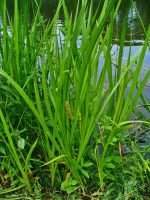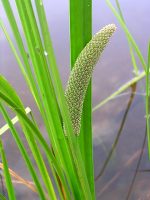 This aquatic perennial goes by many name including beewort, calamus, flag root, gladdon, myrtle flag, pine root, sea sedge and sweet cane. It is native to Asia and Europe where it grows at the edges of small lakes, ponds and rivers, marshes, swamps, and wetlands. Acornus calamus is one of only two species in the family, Acornaceae. Plants have a root system of branching rhizomes and form clumps of basal, sword-like leaves that resembles those of iris. They are up to 30″ long, are flattened, and have one wavy margin and a conspicuous midrib. A 2-4″ long spadix of inconspicuous greenish flowers appear in a diamond pattern in late spring to early summer. The fruit is a tiny fleshy berry. The plant has been used for medicinal purposes but there is no clinical evidence for its safety or efficacy. The leaves and root stock have a pleasant fragrance when crushed and were used as a strewing herb and in perfume making. The plants are valuable for rain, bog, and edges of water gardens. The genus name, Acornus, is from the Greek word άχόρου derived from κόρη which means pupil of the eye and refers to the use of the root juice to cure eye diseases. The specific epithet, calamus, is from the Greek word kάλαμος meaning reed and refers to the appearance of the plant.
This aquatic perennial goes by many name including beewort, calamus, flag root, gladdon, myrtle flag, pine root, sea sedge and sweet cane. It is native to Asia and Europe where it grows at the edges of small lakes, ponds and rivers, marshes, swamps, and wetlands. Acornus calamus is one of only two species in the family, Acornaceae. Plants have a root system of branching rhizomes and form clumps of basal, sword-like leaves that resembles those of iris. They are up to 30″ long, are flattened, and have one wavy margin and a conspicuous midrib. A 2-4″ long spadix of inconspicuous greenish flowers appear in a diamond pattern in late spring to early summer. The fruit is a tiny fleshy berry. The plant has been used for medicinal purposes but there is no clinical evidence for its safety or efficacy. The leaves and root stock have a pleasant fragrance when crushed and were used as a strewing herb and in perfume making. The plants are valuable for rain, bog, and edges of water gardens. The genus name, Acornus, is from the Greek word άχόρου derived from κόρη which means pupil of the eye and refers to the use of the root juice to cure eye diseases. The specific epithet, calamus, is from the Greek word kάλαμος meaning reed and refers to the appearance of the plant.
 Type: Aquatic herbaceous perennial
Type: Aquatic herbaceous perennial
Bloom: Two to four inch long spadix of tiny greenish flowers in late spring
Size: 2-2.5′ H x 1.5-2′ W
Light: Full sun to part shade
Soil: Medium moist to wet (shallow standing water)
Hardiness: Zones 4-10
Care: Low maintenance
Pests and Diseases: None of significance
Propagation: Division of rhizome
Companion Plants: Iris pseudacornus ‘Variegatus’, purple loosestrife, cardinal flower
Outstanding Selections: ‘Variegatus’ (white striped leaves)
Photo Credits: Wikipedia, Wikimedia Commons